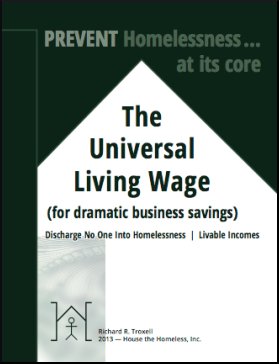
This week is full of significant happenings. The whitepaper, “Prevent Homelessness at its Core — The Universal Living Wage (for dramatic business savings)” is available online, and printed copies are being sent out to the President, Vice President, state Governors, and members of Congress. The author is Richard R. Troxell, president of House the Homeless, which is headquartered in Austin, Texas.
One of the basic ideas this document embraces is that homelessness is way beyond just needing to be “dealt with,” it must be prevented. The great American philosopher Henry David Thoreau said, “There are a thousand hacking at the branches of evil to one who is striking at the root.” Hold that thought, because we will return to it.
Sue Watlov-Phillips, who authored the “Overview” section of the whitepaper, speaks of the media-nourished stereotype in which the lack of a place to live is a problem exclusively owned by the individuals who experience homelessness. This is reminiscent of the bad old days when the racial situation in the United States was characterized as “the Negro problem.”
Eventually, thanks to the actions of countless thousands of courageous people, the so-called Negro problem was correctly identified as a societal problem. Watlov-Phillips writes:
As long as we continue to blame people experiencing homelessness on their individual problems […] it allows us as a society to not address fundamental structural issues in our society that is creating and maintaining homelessness for millions of our people in this country and allows the general society to identify people experiencing homelessness as ‘those people’ instead of our people.
What are the roots of homelessness?
In other words, what are the roots of homelessness? They are embedded, Richard R. Troxell tells us, in two major trenches. One major crisis is that almost no one makes what could fairly be called a livable income any more. If that is not sufficiently obvious in our own lives, we can look to the media for such spectacles as the recent public relations disaster perpetrated by McDonald’s. The corporation’s suggested employee budget not only contained ridiculous expenditure figures, but took for granted that it’s normal for an American to hold down two jobs, just to live one life.
When a person is able to work, is paying them a living wage such a wild idea? When a person is not able to work because of disability, is improving the Supplemental Security Income (SSI) system such a crazy notion? Richard shows how these two things can happen, and illustrates the benefits to both business and taxpayers.
The other relentless contributor to homeless statistics is the ease with which people slip through the safety net, so thin and frayed as to be nonexistent in places. The whitepaper identifies several ways this rupture of the social fabric could be repaired so people stop falling into the abyss. Richard says:
The paper also looks at the concept/tenet: Discharge No One into Homelessness. This is the idea that at no time do we know as much about an individual as when they enter one of our Institutions… Therefore, we should begin to prepare for their eventual discharge into a safe housing environment, immediately.
In the recent past, House the Homeless has examined these institutions in depth, one by one. In a civilized country, the very notion of anyone being discharged from a hospital back onto the streets could make a grown man cry. Young people who already suffer from multiple disadvantages are released from the foster care system into oblivion. Far too many veterans, quite likely to be physically or mentally disabled, are denied the care that was promised them and that is owed them, and abandoned to their fates.
But that’s not all
Of course, there are many other routes to homelessness. An unbelievable number of Americans have lost their homes to the banks. It is worth noting that Sue Watlov-Phillips co-authored Foreclosure to Homelessness: The Forgotten Victims of the Subprime Crisis. In 1983, she founded Elim, the Minneapolis institution that focused on locating transitional housing in duplexes and apartments, rather than shelters. She is also a practicing psychologist, political activist and Board Member Emeritus of the National Coalition for the Homeless.
The other major participant in the creation of the whitepaper is Professor Edgar Cahn, who wrote the Preface. A very condensed version of his distinguished biography includes these phrases:
A graduate of the Yale law school […] started his career in government as special counsel and speechwriter for Attorney General Robert Kennedy… [F]ounded the Citizens Advocate Center… [F]ounded the Antioch School of Law… National Legal Services program… Time Dollar Youth Court…
Of the various genres of people experiencing homelessness, former prisoners are most difficult for the average housed American without a criminal record to sympathize with. But it doesn’t matter how anyone feels about it. The cold, hard fact is that America’s prison population has been artificially and outrageously inflated for the sake of corporate profit, and the more people are caught up in it, the worse everything is going to be for everybody.
Read all of “Prevent Homelessness at its Core — The Universal Living Wage (for dramatic business savings)”or even just the Executive Summary… Tell everyone you meet that we must attack homelessness at its roots by preventing it! You can find the document in its entirety by clicking here or below.
http://www.slideshare.net/slideshow/embed_code/25614159
Prevent Homelessness: The Universal Living Wage from Richard Troxell
Source: “Edgar S.Cahn, Ph.D., Father of Time Banking…,” EthicalMarkets.com


